
Lumen Calculator & Power Calculator
When choosing the wattage or lumen of LED lights, the first thing to consider is the size and purpose of the space used. Different spaces such as living rooms and bedrooms, although of the same area, may have different wattage choices due to the need for softer lighting in the bedroom.
In addition to wattage, another important parameter is luminous flux, also known as lumens. It directly determines the brightness of the lighting fixtures. Sometimes, even if you choose a lamp with the corresponding wattage according to the strategy, you may still feel that it is not bright enough, which is due to the influence of luminous flux. The relationship between luminous flux and wattage can be linked through luminous efficiency, which represents the number of lumens produced per watt. The light efficiency of ordinary lamps is usually between 80-100 lm/watt, while some specially designed lamps such as eye protection lamps may have slightly lower light efficiency, about 60-70 lm/watt, due to the addition of anti blue light, anti glare and other functions.
To determine the required luminous flux, it is also necessary to consider illuminance, which is the luminous flux required per square meter of area. According to the illumination requirements in the residential building lighting standards, we can calculate the required luminous flux. For example, in a 10 square meter bedroom, if the required illuminance is 100lx, then the required luminous flux is 1000lm; And for a 20 square meter living room, if the illumination requirement is 150lx, then the required luminous flux is 3000lm. These luminous fluxes can be provided by a single lamp or achieved through a combination of multiple lamps.
Basic Concepts and Requirements of Indoor Lighting and Illumination
In terms of human vision, without light, there is nothing. In interior design, light is not only used to meet people’s visual functional needs, but also an important aesthetic factor. Light can create, alter, or destroy space, directly affecting people’s perception of object size, shape, texture, and color. In recent years, research has shown that light also affects cell regeneration, hormone production, glandular secretion, as well as physiological rhythms such as body temperature, physical activity, and food consumption. Therefore, indoor lighting is an important component of interior design and should be considered from the beginning of the design process.
Characteristics of Light and Visual Effects

Light, like electromagnetic energy known to humans, is a special form of energy that is a very small part of a vast continuum of electromagnetic radiation with wave like motion. This type of radiation can be measured by its wavelength, and its prescribed unit of measurement is nanometers. When people talk about light, wavelength is often used as a reference, and the total energy contained in radiation waves is also different. The strength of radiation waves is related to their amplitude. The amplitude of a wave is measured by its height or depth, measured by its average point. For example, waves in the sea rise to their highest peak and have their deepest valley, with deeper waves having greater power than shallow waves.
Illumination, Temperature, Brightness
Illuminance
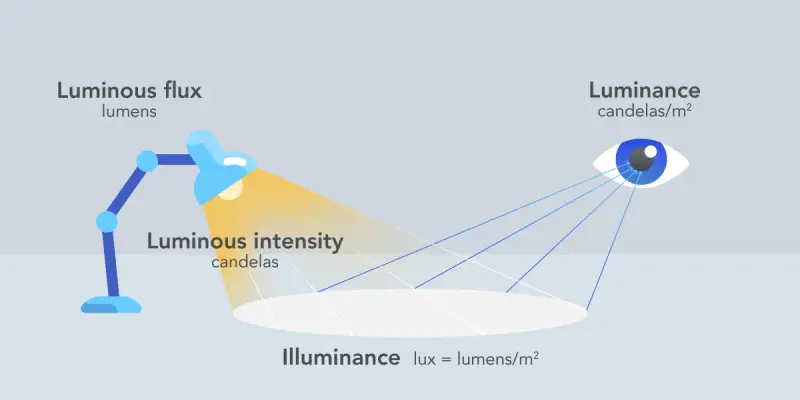
The human eye has different light and dark sensations towards electromagnetic waves of different wavelengths at different radiation levels. This visual characteristic of the human eye is called visual acuity, which is measured by luminous flux as the reference unit.
The unit of luminous flux is lumens, and the unit of luminous efficiency of a light source is lm/W.
The luminous flux emitted by a light source in a unit solid angle in a certain direction is called the luminous intensity of the light source in that direction, measured in candela. The luminous flux received per unit area on the illuminated surface is called illuminance, measured in lux.
Temperature
The color of light mainly depends on the color temperature of the light source and affects the indoor atmosphere. Low color temperature, feels warm; High color temperature, feels cool. Generally, colors with a color temperature below 3300K are considered warm colors, colors with a color temperature below 5300K are considered intermediate colors, and colors with a color temperature above 5300K are considered cool colors. The color temperature of the light source should be adapted to the illuminance, that is, as the illuminance increases, the color temperature should also increase accordingly. Otherwise, under low color temperature and high illumination, it will make people feel extremely hot; Under high color temperature and low illumination, it can create a gloomy atmosphere.
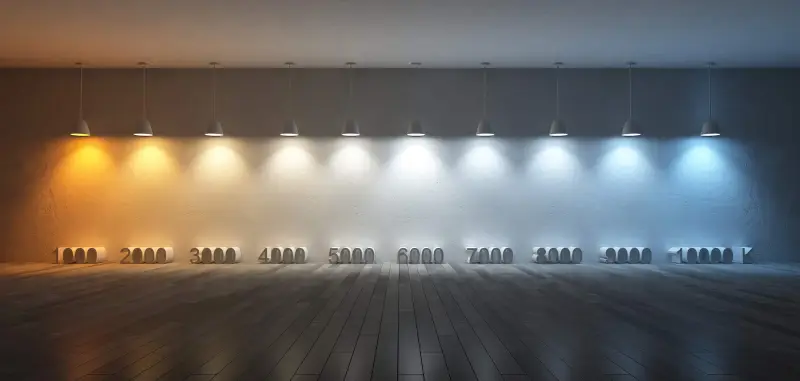
Designers should consider the relationship between light, objects, and space to determine their mutual influence. The intensity of light can affect people’s perception of color, such as red curtains being more vivid under strong light, while weak light will make blue and green more prominent. Designers should consciously utilize lighting fixtures of different colors and adjust them to create the desired lighting effect. A combination of incandescent lamps with point light sources and high-intensity fluorescent lamps with intermediate colors.
The color of artificial light sources is generally expressed in terms of color rendering index, with a maximum Ra value of 100 and excellent color rendering performance above 80; 79-50 has average color rendering; Poor color rendering below 50.
- Incandescent lamp Ra=97;
- Halogen tungsten lamp Ra=95-99;
- White fluorescent lamp Ra=55-85;
- Daytime color lamp Ra=75-94;
- High pressure mercury lamp Ra=20-30;
- High pressure sodium lamp Ra=20-25;
- Xenon lamp Ra=90-94.
Brightness
Brightness, as a subjective evaluation and perception, is different from the concept of illuminance. It represents the amount of light reflected per unit area of the illuminated surface, also known as brightness, and is therefore related to the reflectivity of the illuminated surface. For example, under the same illumination, white paper looks brighter than black paper. There are many factors that affect the evaluation of brightness, such as illuminance, surface characteristics, vision, background, duration of gaze, and even the characteristics of the human eye.
Optical Properties of Materials
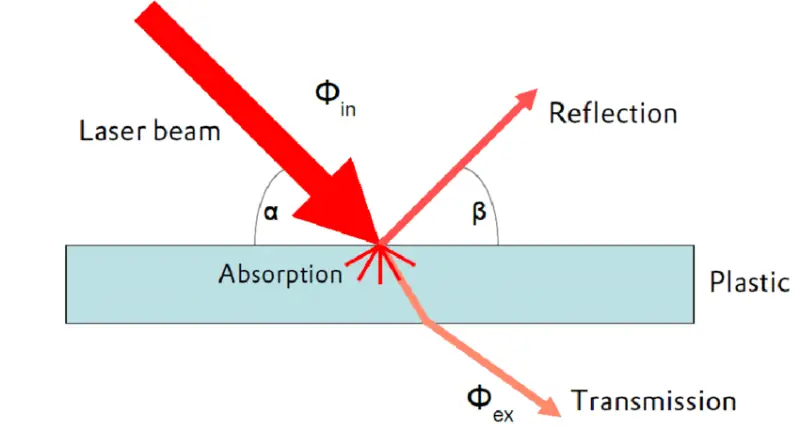
After encountering an object, some light rays are reflected, which is called reflected light; Light can also be absorbed by objects, converted into heat energy, causing the temperature of the object to rise and radiating the heat to the inside and outside of the room, making the absorbed light invisible; There are also some lights that can pass through objects, called transmitted light. The total luminous flux of these three parts of light is equal to the incident luminous flux.
Let the incident light flux be F, the reflected light flux be F1, and the transmitted light flux be F2.
Then the reflectance ρ=F1/F
Transmittance r=F2/F
Absorption rate a=(F-F1-F2)/F
Namely, ρ+r+a=1
When light shines on opaque materials with smooth surfaces, such as mirrors and metal mirrors, directional reflection occurs, with the incident angle equal to the reflection angle and in the same plane; If it hits an opaque rough surface, diffuse light is produced. The transparency of the material causes the transmitted light to leave the material and transmit in different ways. When the two surfaces of the material are parallel, the direction of the transmitted light and the direction of the incident light remain unchanged; If two surfaces are not parallel, the light passing through them will not be parallel due to different refractive angles; Non directional light, also known as diffuse light, is generated by non directional reflections from a relatively rough surface, or by internal reflections and refractions, as well as by relatively large particles inside.
Lighting Control
Control of Glare
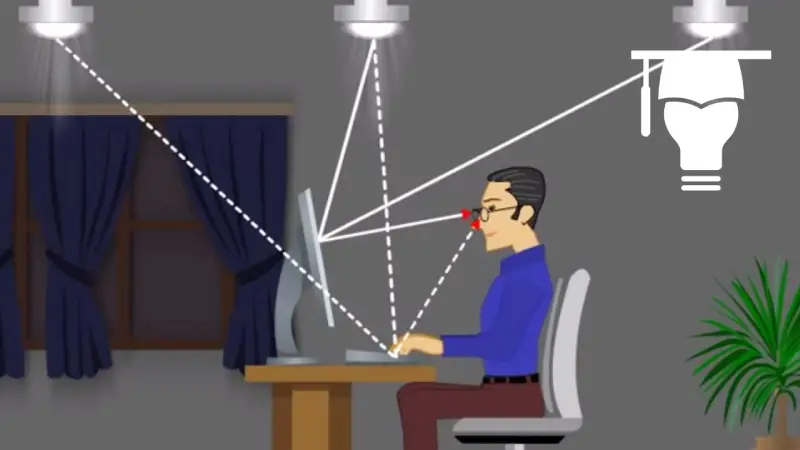
Glare is related to the brightness of light sources and human vision. The direct glare caused by strong light shining directly on the human eye should be shaded; The methods to avoid artificial light sources are to reduce the brightness of the light source, move the position of the light source, and conceal the light source. When the light source is outside the glare zone, that is, beyond 45 ° of the visual level line, the glare is not severe. A light blocking lampshade can conceal the light source and avoid glare. The sum of the occlusion angle and the protection angle is 90 °. The standard for occlusion angle varies from country to country, generally ranging from 60 ° to 70 °, while the protection angle is 30 ° to 20 °. The reflection glare caused by reflected light depends on the position of the light source and the mutual position of the work or gaze surface. The way to avoid it is to adjust its mutual position to outside the visual work area of the reflected light.
Control of Brightness Ratio
Controlling the reasonable brightness ratio and illuminance distribution throughout the room is related to the arrangement of lighting fixtures.
- General Arrangement of Lighting Fixtures
- Overall lighting:Its characteristic is the use of symmetrical fixed lighting embedded in the ceiling, which provides a good horizontal plane for lighting and uniform illumination on the working surface. There are no obstacles in the space where light passes through, and there is sufficient light anywhere, making it easy to arrange furniture and suitable for combining air conditioning and lighting. But with high power consumption, it is uneconomical under energy tight conditions, otherwise the entire illuminance will have to be reduced.
- Local lighting:In order to save energy, light sources are only installed in areas where work needs to be done, and switches and lighting reduction equipment can be provided to adapt the lighting level to different changing needs. But working in a dark room with only a separate light source can easily cause tension and damage to the eyes.
- To improve the drawbacks of overall and local mixed lighting, 90% -95% of the light is used for work lighting, and 5% -10% of the light is used for environmental lighting.
- Angular lighting: It is a method of using specially designed reflectors to direct light towards the main direction. This type of lighting has developed due to the illumination of wall surfaces and the need to express the texture of decorative materials.
- Lighting Zone Zoning
- Ceiling area:commonly used for general lighting or work lighting, due to the special location of the ceiling, it plays an important role in the artistic function of lighting.
- Surrounding area:Located within a regular field of view, lighting should be particularly designed to avoid glare and to simplify. The brightness of the surrounding area should be greater than that of the ceiling area, otherwise it will cause visual confusion, hinder the understanding of the space and the recognition of directions, and hinder the recognition of attractive centers of interest.
- Usage zone: The work lighting in the usage zone is necessary, and usually countries have different minimum illumination standards for workplaces.
The lighting in the above three areas should maintain a subtle balance. It is generally believed that the ratio of lighting in the use area to that in the ceiling and surrounding areas is 2-3:1 or less, and the visual changes tend to be minimal.
- Maximum Allowable Brightness Ratio of Indoor Parts
- The ratio of visual acuity homework to nearby work surface is 3:1;
- The ratio of visual homework to the surrounding environment is 10:1;
- The ratio of light source to background is 20:1;
- The maximum brightness ratio within the field of view is 40:1.
The Casyoo Lighting Laboratory also conducted a survey on the ratio between overall lighting and local lighting in offices. For example, if the total illumination on the desk is 1000LX, it is good if the overall lighting is greater than 50%, good if it is between 35% and 50%, and not good if it is less than 35%.
Indoor lighting location and lighting method
Lighting Location and Type of Light Source
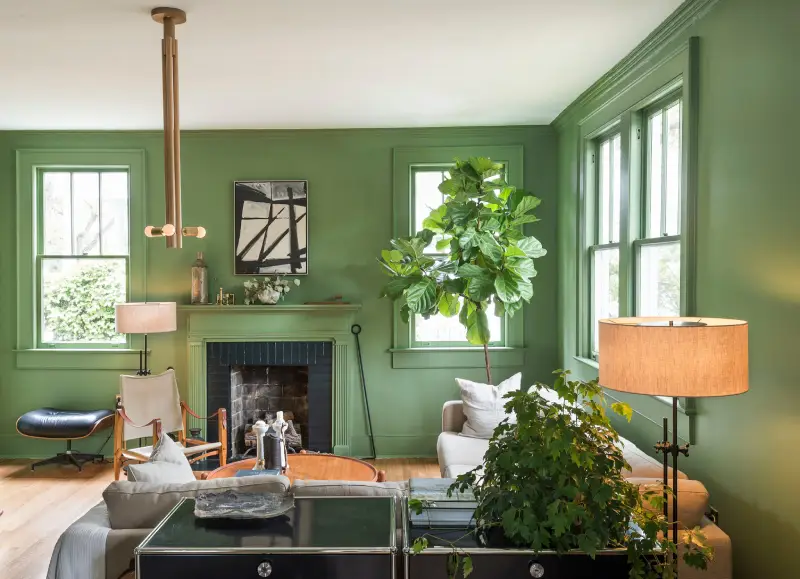
By utilizing natural lighting, not only can energy be saved, but it can also be visually more comfortable and comfortable. Psychologically, it can be close to and coordinated with nature, and outdoor scenery can be seen. It can also meet spiritual requirements. If precise lighting standards are followed, sunlight can provide sufficient indoor lighting throughout the year. The indoor lighting effect mainly depends on the size and layout of the lighting parts and openings, and is generally divided into three forms: side lighting, high side lighting, and ceiling lighting. Side lighting can choose a good orientation and outdoor landscape, making it easy to use and maintain. However, as the depth of the room increases, the lighting efficiency quickly decreases. Therefore, it is common to increase the height of windows or use bidirectional or corner lighting to compensate for this disadvantage.
The illumination distribution of the top light is uniform, and there are few factors that affect indoor illumination. However, when there are obstacles on the upper part, the illumination drops sharply. In addition, it is difficult to manage and maintain.
Indoor lighting is also affected by the surrounding outdoor environment and indoor interface decoration treatment. For example, nearby buildings outside can block the entry of sunlight and reflect some of it from the walls into the interior. In addition, when facing indoors, the window can be regarded as a surface light source, which increases the indoor illumination through the reflection of the indoor interface. From this, it can be seen that the sunlight entering the room is composed of the following three parts:
- Direct daylight;
- External reflected light;
- Indoor reflected light.
DF=SC+ERC+IRC
In addition, the orientation of the windows also affects indoor lighting. When facing the sun, the indoor area receives more light than in other directions. The different transmission coefficients of glass materials used in windows result in different lighting effects indoors.
Sunshade measures are generally taken for natural lighting to avoid glare and discomfort caused by direct sunlight indoors. Wenzhou Hubin Hotel adopts vertical louvers for rest. The skylight in the atrium of Kunming Golden Dragon Hotel adopts white and light curtains, which create diffuse light inside the room, and the light is soft and calm. But sunlight plays an important role in enlivening indoor atmosphere, creating a three-dimensional sense of space, and creating contrasting effects of light and shadow.



